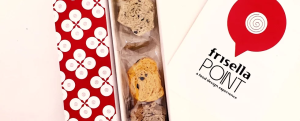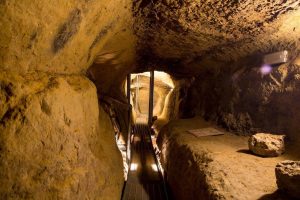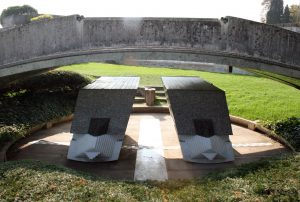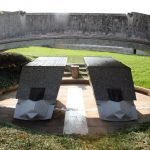There is a small village (sorry, a principality) nestled in the dazzling green hills of the far west of Liguria and overlooking a sea so blue that in the distance it seems painted. Along the alleys and in the medieval squares the white and blue flags of the kingdom flutter in the west wind that blows from the Côte d’Azur. It is called Seborga and has been fighting for half a century to regain independence from Italy. Nature has been generous here: the climate is mild in winter and cool in summer, you are close enough to the Mediterranean to breathe its iodine and cautiously far away to escape the noise of vacationers. We are on the top of a promontory with a wooded ridge that from the Bignone and Caggio mountains descends in terraces scattered with olive trees towards the coast. All around brooms, mimosas and flowers of every shade crown the hills, intoxicating the air with perfumes. At this juncture it is the turn of Princess Nina I (in the world Nina Dobler Menegatto) to lead the fight to free Seborga from the “Italian yoke”, as sanctioned by a plebiscite among its three hundred inhabitants. A de jure independence, according to the sovereign, which has remained entangled in the folds of treaties and history. The matter is summarized as follows: Seborga became an independent state as early as 954, with the donation by Count Guidone di Ventimiglia to the Benedictine monks of the Abbey of Lerino, and in 1079 it became a principality. In 1729 the principality was sold by the religious to Vittorio Amedeo II of Savoy, but the agreed 147,000 Savoy lire was never paid and consequently the deed never registered. No document of the Congress of Vienna reports the Ligurian statelet as part of the Kingdom of Sardinia: the annexation, in 1861, to the Kingdom of Italy and, in 1946, to the current Republic is “to be considered unilateral and illegitimate”. Naturally in Rome they are of the opposite opinion, so much so that the Constitutional Court has rejected Seborga’s autonomist claims as “inadmissible”. The inhabitants do not give up, also because in their constitution it is clearly written: those who do not fight for sovereignty “are to be considered unworthy to trample the ground that God and history have granted them”. In other words, they are traitors. New proceedings are being prepared at the Strasbourg Court of Human Rights and the Hague Tribunal. Will it be the right time? Princess Nina seems to have no doubts, quoting Margaret Thatcher: “If you want something said, ask a man. If you want something done, ask a woman”. While waiting to free themselves from Italy, coins continue to be minted, as in the time of the Benedictines: the luigino is minted whose value would correspond to the New York Stock Exchange (based on an incomprehensible calculation) at six dollars. The currency can be spent in all the shops in the country. The Crown has also created a uniformed police force called the National Guard and placed sentry boxes on the municipal border with the neighboring Vallebona, which still wonders what they are for. Then there are the passports, the stamps, the car plates accompanying the Italian ones, the national football team entrusted to a coach-player. Representative offices abroad have been opened: United States, Argentina, India, Ivory Coast, Germany. There is also the national anthem entitled La Speranza: “Go, be a man and go, dressed in white and blue! And go, seborghino go. Never stop if you find obstacles ». This tiny kingdom also boasts its gossip, almost echoing the vicissitudes that torment nearby Monte Carlo with the crisis between Prince Albert of Monaco and his wife Charlène. Nina is the ex-wife of Prince Marcello I who was forced to abdicate from the throne after being photographed in the affectionate company of luxury bag designer Sofia al Asfoor. For the princess, however, it is a closed chapter: “Let’s talk about three excellent reasons to visit Seborga – she explains with blue eyes and golden hair – the first is history: we are the only example of a Cistercian principality and our artistic jewels testify to this. The second is nature: we are the mimosa capital of the world and the view is breathtaking. From here you can see four states: Seborga itself, Italy and, beyond the Alps, France and the Principality of Monaco. The third reason is the tranquility: we are a small but welcoming and safe country, where the pandemic has hit lightly and where the rules are followed ». In the gastronomic field, the national pride is the rabbit, cooked with olives and pine nuts and served in a terracotta bowl, to be washed down preferably with Rossese di Dolceacqua. The banners wave on the towers and on the three gates that defended from the invader: Porta San Martino, Porta di San Sebastiano and Porta del Sole. The coat of arms stands out on the stone churchyard of the Baroque parish church, built in the seventeenth century by the Genoese architect Arturo Fieschi and dedicated to San Martino di Tours. Whether it is Italian soil or not, this village has been included among the hundred most beautiful in the country: “We are independent because we have never stopped being, nothing is impossible, look at what happened with Brexit”, are the last words of a princess who does not let go of the scepter.
The principality of Seborga, an ancient fairy tale in the heart of Liguria

Intesa vincente. A Lecce la frisella incontra il design con Frisella Point Valorizzare il cibo della tradizione attraverso l’unione delle eccellenze del territorio e del linguaggio contemporaneo dell’estetica a tavola.
A pochi passi dalla Basilica di Santa Croce e da Porta Napoli, la frisella, regina della convivialità delle tavole estive salentine, ha trovato il proprio regno. Frisella Point è un intimo spazio interno, con dehors su piazzetta Santissima Addolorata 14, che si propone al pubblico come “ristorazione culturale”, per valorizzare un prodotto semplice della tradizione […]
Continua a leggere
Il labirinto di Porsenna
*di Bianca Sestini* Oltre al suo magnifico lago, gli Etruschi sono il motivo principale della fama di Chiusi dentro e fuori dalla Toscana. Stando a fonti latine, sarebbe stato uno dei primi insediamenti di questa antica civiltà. Per alcuni la città fu fondata da Telemaco, il figlio di Ulisse, per altri dall’eroe Cluso. Da allora, […]
Continua a leggere
L’inno all’amore della Tomba Brion
*di Carlo Piano* La Tomba Brion è la storia di un amore scritta con acqua, aria e cemento armato. Quando Onorina Tomasin chiese a Carlo Scarpa di creare il mausoleo per ricordare il marito Giuseppe Brion, improvvisamente scomparso, lui accettò a una condizione: doveva avere la parola della vedova che non si sarebbe mai risposata. […]
Continua a leggere









